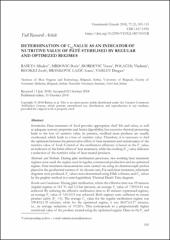| dc.description.abstract | Introduction. Heat treatment of food provides appropriate shelf life and safety, as well
as adequate sensory properties and better digestibility, but excessive thermal processing
leads to the loss of nutritive value. In practice, sterilised meat products are usually
overheated, which leads to a loss of nutritive value. Therefore, it is necessary to find
the optimum between the preservative effect of heat treatment and maintenance of the
nutritive value of food. Control of the sterilisation efficiency is based on the Fo value,
an indicator of the lethal effect of heat treatment, while the cooking (Co) value indicates
a reduction of the nutritive value of heat treated products.
Materials and Methods. During pâté sterilisation processes, two working heat treatment
regimes were used: the regime used in regular, commercial production and an optimised
regime. Heat treatment measurements were carried out using six thermocouple probes
placed in the geothermal centres of six chosen cans. For each heat treatment, schematic
diagrams were produced. Fo values were determined using Ellab software, and Co values
by the graphic method in a semi-logarithmic Thermal Death Time diagram.
Results and Conclusions. During pâté sterilisation, where the effective time was 55 minutes
(regular regime) at 114 °C and 3.2 bar pressure, an average Fo value of 7.90±0.43 was
achieved. By reducing the effective sterilisation time to 45 minutes (optimised regime),
an average Fo value of 3.81±0.5 was achieved. Both regimes were sufficient to ensure
product safety (Fo >3). The average Co value for the regular sterilisation regime was
109.83±1.33 minutes, while for the optimised regime, it was 88.67±4.27 minutes,
i.e., an average reduction of 19.26%. This corresponds to a proportionally higher
nutritional value of the product treated using the optimised regime. Data on the Fo and
Co values achieved during the sterilisation process can make a significant contribution
to obtaining products with a better nutritional value through an optimised sterilisation
process, without jeopardising product safety. | en_US |

